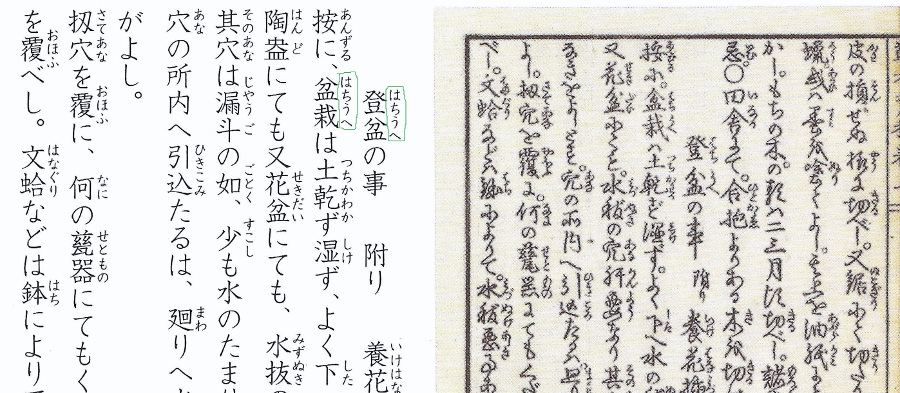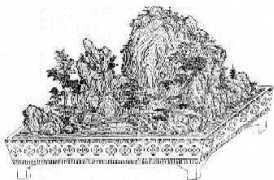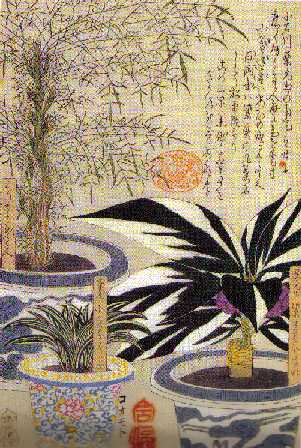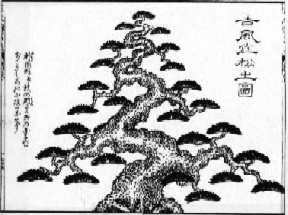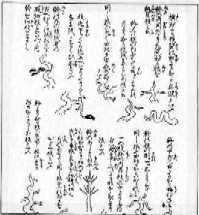|
NOTES
1
Young, Dorothy Bonsai, The Art and Technique (Englewood Cliffs, NJ: Prentice-Hall, Inc.;
1985), pg. 7, gives the date as 1822, b&w pictures courtesy of Kyuzo Murata; cf. Lesniewicz, Paul
Bonsai: The Complete Guide to Art & Technique (Poole, Dorset: Blandford Press; 1984), pg. 13, who
shows a sepia photo (attributed to Dr. Horace Clay of Hawaii), with the caption "1808, a pun-ching by Sumie Buzen."
What is shown is a detailed mountain landscape, in a round or oval light-colored pot with dark geometric patterns on the
sides. The groundcover goes up the sides of the rocks, and there are at least two thin taller trees, possibly
pines. A tiny, squat, open-walled hut with a pyramidal roof on four supports is in a flat clearing in this
landscape. Two tiny seated figures to the left are gazing out over the edge of this world. This picture is
very similar to the first one from the son's book mentioned above; Lesniewicz,Paul Bonsai in Your Home
(NY: Sterling Publishing Company, Inc.; 1994), pg. 59 has color reverse print and full depiction of landscape that
is shown in Complete Guide ; Stein, Rolf A. The World in Miniature (Stanford, CA:
Stanford University Press; 1990), pg. 34, has another miniature landscape of similar style, also dated 1808.
And, the one copy listed in the Japanese university library holdings database (
http://webcat.nii.ac.jp/webcat_eng.html )
is dated 1808; per the Library of Congress Online Catalog,
http://catalog.loc.gov/,
an edition from possibly Osaka is dated not before 1826, LCC #98847211.
GoogleBooks
also lists only an 1826 edition published by Imazuya Tatsusaburō. A 1925 edition out of Kyoto is LCC
#96470979. Except for the LOC citations, all the other above sources give only the first word of the
title. A b&w of the print in Lesniewicz is also in Covello, Vincent T. and Yuji Yoshimura
The Japanese Art of Stone Appreciation, Suiseki and Its Use with Bonsai
(Rutland, VT: Charles E. Tuttle; 1996, 1984), pg. 104.
A copy of an 1842 27-page
work, Senkeiban Zushiki Joukan Vol. 1 by the artist Shofuzan Houzou, was on
e-Bay
up to the end of Sept. 2007. The winning bid was US$910. For educational comparison,
above we have two images from the 1842 work.
An 1822 edition was offered for sale to the
Phoenix club 3 Mar 2011 by www.carolynstaleyprints.com
with these details describing it: Senkeiban zushiki (Pictures and methods of placing miniature landscapes on dishes),
edited by Takashi Katsutada, 26 x 18.4 cm, 24 different gardens illustrated on 30 illustrated pp. with
10 pp. text (4 introduction and 6 colophon). Woodblock with attractive hand-colored accents. In posting per Mitchell
on ausbonsai.com 29 Jul 2011, volume one has been located and posted at
http://www.ausbonsai.com/forum/viewtopic.php?f=27&t=8869&p=97371#p97239,
visible when you sign up for a free membership in the Australian Bonsai Forum.
Volume 2 was said to follow, but has not shown up yet. When it does, it will be linked here also. The blog
article, "Japanese
'Penjing' From an 1826 [sic] Book" by Bonsai Penjing & More, October 7, 2016,
was brought to RJB's attention courtesy of the November 15, 2016 issue of Mary Miller's excellent newsletter,
Bonsai Banter.
2
Bartlett, Harley Harris and Hide Shohara
Japanese Botany During the Period of Wood-Block Printing
(Los Angeles: Dawson's Book Shop; 1961. Reprinted from ASA GRAY BULLETIN, N.S. 3:
289-561, Spring 1961), pg. 252; Newsom, Samuel Japanese Garden Construction
(Tokyo: Domoto, Kumagawa and Perkins, 1939. 1988 reprint by Apollo Book,
Poughkeepsie, NY), pg. 281, lists this as an 1815 garden book by Abe Rekisai;
Liang, Amy The Living Art of Bonsai (New York: Sterling Publishing
Co., Inc.; 1992), pg. 107 states that "In Abe Kijin's (1821)
Propagating Plants and Trees, bonsai is mentioned along with notes explaining the
Japanese pronunciation 'hachiue,' which means potted plant."; per the Library of Congress Online Catalog,
http://catalog.loc.gov/, the Kyoto publisher was Katsumura Jiemon, while the Edo one
was Yamashiroya Sahee in Bunka 15 (1818), LCC #98847230. "IWASS1,"
http://www.hanshan.com/j/IWASS1.HTM, which also offers a copy of
the manuscript for GBP 1,150.00 (approx. US $1,875) as of 30 Jul 2011; "Iwasaki Tsunemasa," Spencer Research Library,
http://spencer.lib.ku.edu/exhibits/easternBotanicals/iwasakitsunemasas/index.html;
The Story of "Bonsai", The History of Bonsai from ancient times to the present, The Omiya Bonsai Art Museum,
Saitama, issued on March 21, 2014.
3
Bartlett, pg. 172, has a b&w photo of a page from, and translates the title as
Collection of unusual plants [with drawings and writings by many experts], giving the publication data
as Edo, Bunsei 10 (1827); Yashiroda, Kan "The Amateur Bonsai Fancier" in Yashiroda Handbook on Dwarf Potted
Trees (NY: Brooklyn Botanic Garden, 1953, 1959), has b&w photo on pg. 83 and states on pg. 82
that "The accompanying photograph of winter daphne (D. odora) is reproduced from a book published in
1827; it shows a crested branch which was rooted as a cutting and perpetuated [sic]
and trained as a bonsai."; Titley, Norah and Frances Wood Oriental Gardens, An Illustrated History
(San Francisco: Chronicle Books; 1991), pg. 116 Fig. " 109 Pot plants (three varieties of Nandina
domestica by Untei)... hand-coloured woodblock... "; Del Tredici, Peter Early American Bonsai
(Jamaica, MA: Arnold Arboretum, Harvard University; 1989), pp. 14-15 and 22, states the author as Kintaro; cf.
Wichmann, Siegfried Japonisme: the influence on Western art in the 19th and 20th centuries (New York: Park
Lane; 1980. English translation, 1981), pp. 330-331: "There are indications that the design studio of the
Daum Workshop in Paris [c.late 1880's] had access to the work So-moku Ki-hin
Kaga-mi, published by printers and botanists in Kyoto in 1828. Individual parts -- mostly boughs --
are copied exactly on the ornamental vases of the brothers Daum. Many Japanese botanical books, in fact,
were used in Europe as reference materials for Japan inspired artwork, crafts and designs." Per the article
A Careful Selection of Whisk
Ferns (1837), in The Public Domain Review, Whisk ferns -- Psilotum to botanists,
matsubaran in Japanese -- belonged to a category of plants called kihin, curious and rare specimens
for which there was a fad among collectors during the latter part of the Tokugawa Shogunate. Printed
illustrations could forever freeze these unique cultivars in the moment of their highest flowering or fullest
leaf. But publishers of books who fed into the kihin craze sometimes ran afoul of the period's harsh
sumptuary
laws, which strictly regulated the consumption and display of luxury items according to one's social status.
Such is the case for Catalogue of Extraordinary Plants (Somoku Kihin Kagami), whose unfortunate
editor, Kinta the Gardener, had his property seized
and his woodblocks burned before being banished from the capital forever -- fitting punishment, so it was apparently
thought, for promoting such dangerous indulgences." "Chabo-hiba" material from Peter Del Tredici's
From
Temple to Terrace, The Remarkable Journey of the Oldest Bonsai in America, Harvard Arboretum, Nov 15, 2006,
which states that Somoku Kihin Kagami, was published originally in 1827 and reprinted in facsimile 1976 with
modern Japanese characters and Latin plant names (Kintaro, 1827; Tsukamoto, 1976; Tokyo: Seiseido (in Japanese).
4
Liang, pg. 107.
5
Naka, John and Richard K. Ota and Kenko Rokkaku
Bonsai Techniques for Satsuki
(Ota Bonsai Nursery; 1979), pg. 32, lists the author as Mizuno Tadaki; Tsumura, Toichi, M.F.S.
"Dwarf Trees,"
Japan Society: Transactions (Vol. VI, Part 1, pp. 2-15), pg. 11 includes
quote about; Nippon Bonsai Association Classic Bonsai of Japan
(Tokyo and New York: Kodansha International; 1989), pp. 150-152 have three
b&w photos of pages and pine-grower quote from. First photo [above] from pg.
151, described as "A picture of a 'classical pine bonsai'"
and second photo [above], same page, as "An explanation...of
kannuki-eda,kuruma-eda, and other 'taboo' branch formations."; Bartlett, pp. 172-173, with b&w
photo of page from on pg. 174, Fig. 47.
6
"Notes on Antique Chinese Bonsai Pots" by Ikune Sawada,
Bonsai Magazine, BCI, September/October 1988, Vol. XXVII, No. 5, pg. 25;
Bonsai Magazine, BCI, Vol. XXXII, No. 3,
May/June 1993, pg. 23, mentions an 1818 gardening guide by Kanen Iwasaki, Somoku-Ikushu:
but see author of work with Note 2 (above). Per
Journal of Botany, British and Foreign,
1887, Vol. 25, pg. 226: "Iwasaki Tsunemasa, of Yedo, was a superintendent of a botanic garden belonging to
Shogun, and also the author of 'Somoku Ikushu,' published in two volumes about 1817."
7
Yashiroda, Kan Bonsai, Japanese Miniature Trees (Newton, MA: C.T. Branford
Co./London: Faber and Faber; 1960), pp. 21-22, which has no author specified and the date as 1830; Koreshoff,
Deborah R. Bonsai: Its Art, Science, History and Philosophy (Brisbane, Australia: Boolarong
Publications; 1984), pg. 8, no author and 1830 date; Nippon Bonsai Association Classic Bonsai of
Japan, pp. 149-150, has two b&w photos of pages from, and lists the publication date as 1833; Ishiyama,
Nonkey T. "Historical Notes on Japanese Bonsai," Bonsai Journal, ABS, Vol. 5, No. 3, Fall 1971, pp. 43-
44 has b&w [shown above] on latter page captioned "Illustrations [sic]
from a book of Japanese potted plants dated 1830. From the collection of N.T. Ishiyama"; cf. Shufunotomo,
Editors of The Essentials of Bonsai (Portland, OR: Timber Press; 1982), pg. 9, has date of 1803; and
Newsom, pg. 281, has "Kinsei Zu-fu by Choseisha, an 1832 garden book"; per personal e-mail dated Jan. 23,
2020 to RJB from John Romano (who owns a copy of the work) the author, title, date and size are as listed above;
details per John Romano in Facebook posting Jan. 22, 2020; per the Library of Congress Online Catalog,
http://catalog.loc.gov/, the Kyoto publisher was Katsumura Jiemon, while
the Edo one was Suharaya Sasuke, LCC #98847182. Only the LOC citation lists the third word in the title.
The Minneapolis Institute of Art has a copy in their Mary Griggs Burke Collection,
Manual on Arboriculture,
showing an open double-page with two illustrations; Lot-Art has a
different
double-wide illustration but gives the year of publication as 1836; there is a copy at
Yale and at
Harvard,
in addition to one in the Library
of Congress.
8
Bartlett, pg. 253, having the author's name as "Abe Yoshito," with b&w of the
right-hand plate of the sample pages shown above on pg. 254 as Fig. 101; Nippon Bonsai Association
Classic Bonsai of Japan, b&w on pg. 149; Yashiroda, Kan "The Amateur
Bonsai Fancier," has b&w photo on pg. 83 also of the right hand plate
from above and states on pg. 82 that "The second photograph is reproduced
from a book published in 1837. The first glance shows merely a completed
bonsai; but closer inspection reveals that on each branch of the thread-form
Sawara cypress (
Chamaecyparis pisifera filifera
) one to three scions of Hiba arbor-vitae, or false arbor-vitae (
Thujopsis dolabrata
), have been grafted. When the graft unions are completed, all the branches
of the Sawara cypress are to be cut off and the whole tree converted into
Hiba arbor-vitae.
"These are not childish attempts
or vague ideas but are the products of long years of an age of military
ascendency, when every profession was hereditary -- the time called the
Tokogawa Era...";
per the Library of Congress Online Catalog,
http://catalog.loc.gov/, the Edo publisher was Suharaya Mohe, LCC
#98847832; the three part author's name is per "IWASS1,"
http://www.hanshan.com/j/IWASS1.HTM.
9
Nippon Bonsai Association
Classic Bonsai of Japan, pg. 150. See also No. 2 work above.
10
Yoshishige --
"53 Tokaido Bonsai -- Nihonbashi" and subsequent pages in Ukiyoe-Gallery.com;
GoogleBooks.
A copy of this was also offered for sale to the
Phoenix club 3 Mar 2011 by www.carolynstaleyprints.com.
|
